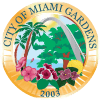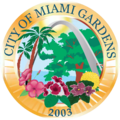Miami Gardens, Florida facts for kids
Quick facts for kids
Miami Gardens, Florida
|
|||
|---|---|---|---|
| City of Miami Gardens | |||
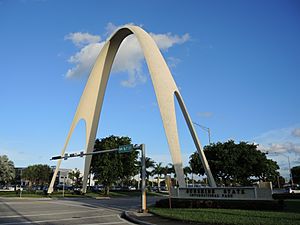
The Sunshine State Arch of Miami Gardens
|
|||
|
|||
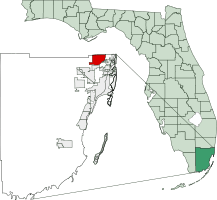
Location in Miami-Dade and the state of Florida.
|
|||
| Country | |||
| State | |||
| County | |||
| Incorporated | May 13, 2003 | ||
| Government | |||
| • Type | Council-Manager | ||
| Area | |||
| • City | 19.00 sq mi (49.21 km2) | ||
| • Land | 18.23 sq mi (47.21 km2) | ||
| • Water | 0.77 sq mi (2.00 km2) | ||
| Elevation | 7 ft (2 m) | ||
| Population
(2020)
|
|||
| • City | 111,640 | ||
| • Density | 5,875.8/sq mi (2,268.6/km2) | ||
| • Metro | 5,564,635 | ||
| Time zone | UTC−5 (EST) | ||
| • Summer (DST) | UTC−4 (EDT) | ||
| ZIP codes |
33014, 33054, 33055, 33056, 33152, 33169
|
||
| Area code(s) | 305, 786, 645 | ||
| FIPS code | 12-45050 | ||
| GNIS feature ID | 1989951 | ||
| Website | miamigardens-fl.gov | ||
Miami Gardens is a city in the northern part of Miami-Dade County, Florida, in the United States. It's a suburb of Miami, located about 16 miles north of Downtown Miami. The city's name comes from Florida State Road 860, also known as Miami Gardens Drive. In 2020, about 111,640 people lived there.
Miami Gardens is special because it's Florida's largest city with a majority African American population. About 67% of its residents are African American, which is the highest percentage in any Florida city. It's also part of the large Miami metropolitan area, which is one of the biggest in the world. The city is home to Hard Rock Stadium, a huge sports venue. This stadium is where the Miami Dolphins (an NFL team) and the Miami Hurricanes (the University of Miami's college football team) play their games.
Contents
History of Miami Gardens
In the late 1960s, after the I-95 highway was built, many African American and West Indian American families moved to the area that became Miami Gardens. They came from other Miami neighborhoods like Liberty City. This happened after the Fair Housing Act made it illegal to have housing rules based on race.
Miami Gardens officially became a city on May 13, 2003. Before that, its neighborhoods like Andover, Bunche Park, Carol City, Lake Lucerne, Norland, Opa-locka North, and Scott Lake were not part of any city. They were just "unincorporated areas" within Miami-Dade County.
In 2012, Oliver Gilbert became the city's second mayor. He suggested creating a Community Redevelopment Agency (CRA). CRAs help improve areas that need a lot of work. They use local property taxes to make the city better and encourage new businesses.
Looking ahead, Hard Rock Stadium in Miami Gardens will host several matches during the 2026 FIFA World Cup. This is a big event for the city!
Population and People
Miami Gardens has grown over the years. In 2020, the city had 111,640 residents.
Who Lives in Miami Gardens?
The city is very diverse. According to the 2020 census:
- About 61.87% of the people are non-Hispanic Black or African American.
- About 32.88% are Hispanic or Latino (who can be of any race).
- Smaller groups include non-Hispanic White, Asian, Native American, and people of two or more races.
In 2016, about 72% of households were families. The average household had about 3.52 people. The city covers about 20 square miles.
Sports and Entertainment
Miami Gardens is a major hub for sports and entertainment.
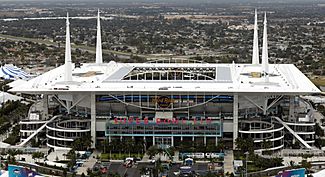
The Calder Race Course, a horse racing track, opened here in 1971.
The city is most famous for Hard Rock Stadium. This stadium is the home of the Miami Dolphins, an NFL team. It also hosts the annual Orange Bowl college football game. The University of Miami's Hurricanes football team plays here too. The Miami Open tennis tournament is also held at the stadium.
In recent years, the Miami International Autodrome has hosted the Miami Grand Prix for Formula One racing in 2022, 2023, and 2024.
Healthcare Services
Miami Gardens has several healthcare places for its residents. While there isn't a main hospital directly in the city, places like Jackson North Medical Center, Concentra Urgent Care, and Chen Medical Center offer many services. These include general check-ups, urgent care, dental services, and physical therapy. They also provide tests like x-rays and vaccinations.
Economy and Business
In 2003, a company called Merchandize Liquidators was started in Miami Gardens. This shows that the city is a place where businesses can grow.
Education in Miami Gardens
Miami Gardens has many schools for students of all ages.
Public Schools
The Miami-Dade County Public Schools system runs the public schools in the area.
Elementary Schools
Here are some of the elementary schools in Miami Gardens:
- Brentwood Elementary School
- Bunche Park Elementary School
- Norwood Elementary School
- North County Elementary School
- Skyway Elementary School
- Parkway Elementary School
Middle Schools
Some middle schools in Miami Gardens include:
- North Dade Middle School
- Lake Stevens Middle School
- Parkway Middle School
- Carol City Middle School
Norland Middle School, located in the Miami Gardens area, has a special program for dance, music, theater, and art. This program started in 1985. Famous young actors like Alex R. Hibbert and Jaden Piner, who were in the Oscar-winning movie Moonlight, trained at this school.
K–8 Schools
Miami Gardens also has a K–8 school, which means it serves students from kindergarten all the way through 8th grade:
- North County K–8 Center
High Schools
The main high schools in Miami Gardens are:
- Miami Carol City Senior High School
- Miami Norland Senior High School
Private Schools
The Archdiocese of Miami operates Catholic schools in the area. Monsignor Edward Pace High School is located within Miami Gardens.
Colleges and Universities
For students looking to continue their education after high school, Miami Gardens is home to several colleges and universities:
- St. Thomas University
- Florida Memorial University
- Sullivan and Cogliano Training Centers
Public Libraries
The Miami-Dade Public Library System operates the North Dade Regional Library. This library opened in September 1979 and serves the community.
Notable People from Miami Gardens
Many talented people have come from Miami Gardens, including:
- Denzel Curry, a rapper and songwriter
- Diamante, a professional wrestler
- Andre Johnson, a retired NFL football player
- Peter O’Brien, a professional baseball player
- Jo Marie Payton, an actress and singer
- Omar Jeffery Pineiro, a rapper, songwriter, and producer
- Lil Pump, a rapper and songwriter
- Flo Rida, a rapper and songwriter
- Rick Ross, a rapper and songwriter
- Jeremiah Smith, a wide receiver for the Ohio State Buckeyes
Images for kids
See also
 In Spanish: Miami Gardens para niños
In Spanish: Miami Gardens para niños



